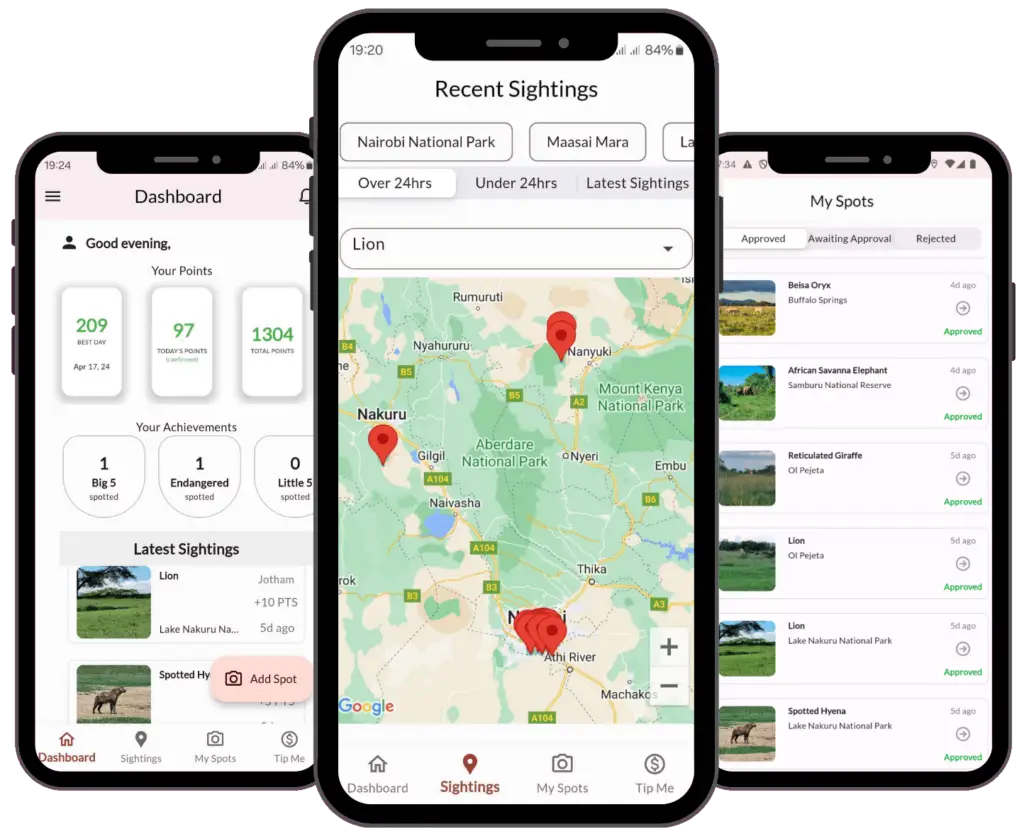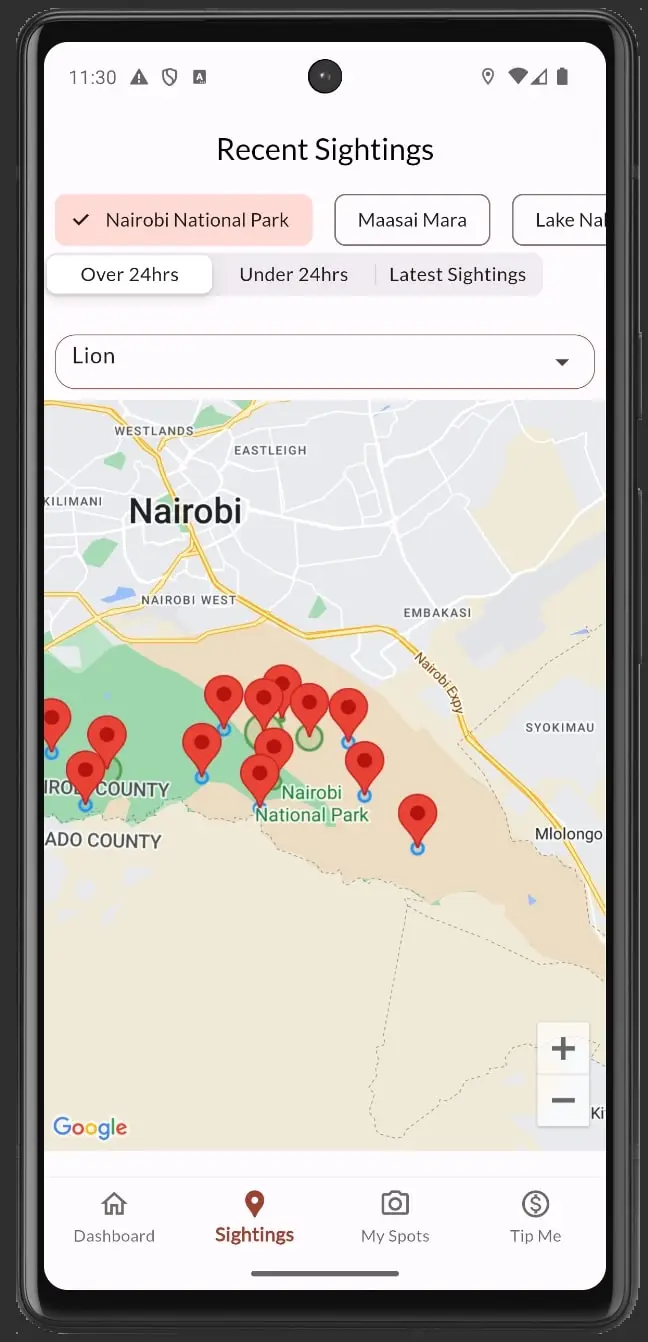All images and facts are contributed by users. Want to contribute or have spotted an error? Email us at hello@safari-driver.com. Image rights belong to the original contributors. Search by: Animal (e.g., Giraffe, Eagle), Category (e.g., Big, Special), or Conservation Status (e.g., Endangered, Vulnerable)
SWAHILI NAME: Korongo
CONSERVATION STATUS: Least Concern
POTENTIAL LOOKALIKES: Egret
DISTINGUISHED BY: Long legs and pointed beak
1. Over 70 species, including egrets
2. Uses a patient hunting technique, standing still to spear fish with its beak
PHOTO CREDIT: Jotham A
SWAHILI NAME: Kiboko
CONSERVATION STATUS: Vulnerable
POTENTIAL LOOKALIKES: N/A
DISTINGUISHED BY: Massive size and barrel-shaped body
1. Third largest land mammal, capable of running up to 30 km/h
2. Closest living relatives are whales and dolphins
PHOTO CREDIT: Jotham A
SWAHILI NAME: Hondo Hondo
CONSERVATION STATUS: Vulnerable
POTENTIAL LOOKALIKES: Toucan
DISTINGUISHED BY: Large, curved bill
1. Over 60 species of hornbill exist worldwide.
2. In most species, after mating, the female seals herself inside a tree cavity while nesting to reduce predation, while the male brings her food.
PHOTO CREDIT: Jotham A
SWAHILI NAME: Fisi Madoa
CATEGORY: Ugly 5
CONSERVATION STATUS: Least Concern
POTENTIAL LOOKALIKES: Striped Hyena, Aardwolf
DISTINGUISHED BY: Spotted coat and bear-like face
1. Live in matriarchal clans, with status often inherited by offspring
2. Cubs are born aggressive and may attack/kill their siblings before reaching one month of age
PHOTO CREDIT: Jotham A
SWAHILI NAME: Pimbi/Perere
CONSERVATION STATUS: Least Concern
POTENTIAL LOOKALIKES: N/A
DISTINGUISHED BY: Stocky body, short tail, and tusk-like upper teeth
1. Rock hyraxes are more social, living in colonies of up to 50, while tree hyraxes are nocturnal and more solitary.
2. Hyraxes use the same “toilet” spots, leaving white urine deposits on rocks.
PHOTO CREDIT: Luvai Gohar
SWAHILI NAME: Kwarara
CONSERVATION STATUS: Least Concern
POTENTIAL LOOKALIKES: Heron, Egret
DISTINGUISHED BY: Long, curved beak
1. The African sacred ibis was revered by Ancient Egyptians, associated with the god Thoth.
2. Highly social, they nest in large colonies and often feed in groups of up to 20 individuals.
PHOTO CREDIT: Jotham A
SWAHILI NAME: Swala pala
CONSERVATION STATUS: Least Concern
POTENTIAL LOOKALIKES: Thomson’s gazelle, Grant’s gazelle
DISTINGUISHED BY: Slender legs, sleek reddish-brown coats, white inner ears
1. Can leap up to 33 feet (10 meters) in a single bound
2. Impalas synchronize their reproductive cycles, with all females giving birth around the same time
PHOTO CREDIT: Jotham A
SWAHILI NAME: Bweha Mgongo Mweusi
CONSERVATION STATUS: Least Concern
POTENTIAL LOOKALIKES: N/A in Africa (Fox)
DISTINGUISHED BY: Bushy tail and pointed ears
1. The smaller black-backed jackal prefers open plains, while the larger side-striped jackal dwells in woodlands and scrub areas.
2. Often heard howling at night.
PHOTO CREDIT: Jotham A
SWAHILI NAME: Tandala
CONSERVATION STATUS: Vulnerable
POTENTIAL LOOKALIKES: Eland
DISTINGUISHED BY: Long, spiral horns (in males)
1. Kudus can easily leap over 8-foot obstacles.
2. Greater kudus are larger with longer horns and fewer stripes, while lesser kudus are smaller with shorter horns and more stripes.
PHOTO CREDIT: Erasti Photography
SWAHILI NAME: Chui
CATEGORY: Big 5
CONSERVATION STATUS: Vulnerable
POTENTIAL LOOKALIKES: Cheetah
DISTINGUISHED BY: Dark, irregular rosettes (spots) vs. cheetah’s solid, rounder spots
1. Leopards are the smallest of the big cats, but muscular. They can carry twice their body weight up into trees.
2. Leopards are found in over 60 countries but are notoriously hard to spot in the wild.
PHOTO CREDIT: Jotham A
SWAHILI NAME: Simba
CATEGORY: Big 5
CONSERVATION STATUS: Vulnerable
POTENTIAL LOOKALIKES: N/A
DISTINGUISHED BY: Male’s majestic mane, unpatterned coat unlike other big cats
1. Super prides can range from 40-60 members
2. Lions have tongues covered in backward-facing spines called papillae, made of keratin. These help them strip meat from bones, groom efficiently, and even aid in drinking water—just like all cats.
PHOTO CREDIT: Jotham A
SWAHILI NAME: Mbega Mweupe
CONSERVATION STATUS: Vulnerable
POTENTIAL LOOKALIKES: Other monkeys
DISTINGUISHED BY: Black fur with long white mantle and a flowing white tail
1. Like other colobus monkeys, it has no thumbs—its name comes from the Greek word kolobós, meaning mutilated.
2. Has a four-chambered stomach, like cows, allowing it to digest tough leaves, including some that are toxic to other animals.
PHOTO CREDIT: Roy Wangui
SWAHILI NAME: Tumbili
CONSERVATION STATUS: Least Concern
POTENTIAL LOOKALIKES: Other Monkeys
DISTINGUISHED BY: Small size, grey fur, black face
1. Display human-like traits such as hypertension, anxiety, and alcohol use
2. Uses specific alarm calls for predators, e.g., leopards, eagles, and snakes, triggering precise escape responses.
PHOTO CREDIT: George Kamau
SWAHILI NAME: Choroa Beisa/Bara Bara
CATEGORY: Special 5
CONSERVATION STATUS: Endangered
POTENTIAL LOOKALIKES: Fringe-eared Oryx
DISTINGUISHED BY: Long, straight horns and greyish coat with no fringes on the ears
1. Its pale coat helps reflect sunlight, and it can sense distant rainfall
2. Can go weeks without drinking water by extracting moisture from plants
PHOTO CREDIT: Jotham A
SWAHILI NAME: Mbuni
CONSERVATION STATUS: Least Concern
POTENTIAL LOOKALIKES: Somali ostrich
DISTINGUISHED BY: Larger size and longer neck
1. Fastest bird on land, running up to 70 km/h
2. Lays the largest eggs of any bird
PHOTO CREDIT: Jotham A
SWAHILI NAME: Mbuni/Mbuni Somali
CATEGORY: Special 5
CONSERVATION STATUS: Vulnerable
POTENTIAL LOOKALIKES: Common ostrich
DISTINGUISHED BY: Blue neck and legs
1. Slightly smaller than the common ostrich
2. Adapted to very hot, dry environments, able to survive without water for long periods
PHOTO CREDIT: Jotham A
SWAHILI NAME: Askari wa Kifaru
CONSERVATION STATUS: Least Concern
POTENTIAL LOOKALIKES: Yellow-billed Oxpecker, Buffalo Weavers
DISTINGUISHED BY: Red bill, yellowish eyes, and brownish body
1. Feeds on ticks, dead skin, and parasites from mammals like rhinos and buffalos, benefiting both itself and its host
2. Known for aggressive feeding behavior, sometimes pecking at the wounds of its host
PHOTO CREDIT: Jotham A
SWAHILI NAME: Mwari/Miari
CONSERVATION STATUS: Least Concern
POTENTIAL LOOKALIKES: Marabou Stork, Stork
DISTINGUISHED BY: Large throat pouch.
1. One of the largest flying birds, with a wingspan of up to 3.6 meters (12 feet), soaring effortlessly on warm air currents.
2. Its gular pouch is for scooping fish, not storing them—it drains water before swallowing its catch.
PHOTO CREDIT: Luvai Gohar
SWAHILI NAME: Chatu
CONSERVATION STATUS: Least Concern
POTENTIAL LOOKALIKES: Other pythons
DISTINGUISHED BY: Large size with a mix of dark and light patches on its body
1. The rock python is the largest snake in Africa, reaching up to 6.5 meters (21 feet) long.
2. As a powerful constrictor, it preys on mammals, birds, and reptiles—including large animals like antelopes and even crocodiles.
PHOTO CREDIT: Roy Wangui
SWAHILI NAME: Tohe
CONSERVATION STATUS: Least Concern
POTENTIAL LOOKALIKES: Mountain Reedbuck, Bushbuck
DISTINGUISHED BY: Lacks stripes or spots found on bushbuck; has a more uniform tan coat and white underparts.
1. Bohor Reedbuck is stockier with a yellowish coat and lives in wet lowlands, while Mountain Reedbuck is slimmer, greyer, and found in rocky highlands.
2. Emits a sharp whistle and performs high, bounding jumps when alarmed.
PHOTO CREDIT: Jotham A
SWAHILI NAME: Kifaru
CATEGORY: Big 5
CONSERVATION STATUS: Critically Endangered
POTENTIAL LOOKALIKES: White rhino
DISTINGUISHED BY: Hooked upper lip, narrower mouth/jaw, deep arched back
1. Mostly solitary and territorial, aggressively defending their territory
2. Feed mainly on bushes and woody plants, preferring browsing over grazing
PHOTO CREDIT: Jotham A
SWAHILI NAME: Kifaru
CATEGORY: Big 5
CONSERVATION STATUS: Endangered
POTENTIAL LOOKALIKES: Black rhino
DISTINGUISHED BY: Broad/wide, square shaped mouth, named after the word “wyd/weit”, slightly humped back
1. Largest rhino species and second largest land mammal
2. Consume over 50kg of vegetation daily and return over 20kg of dung
PHOTO CREDIT: Jotham A
SWAHILI NAME: Kambu
CONSERVATION STATUS: Least Concern
POTENTIAL LOOKALIKES: Other rollers
DISTINGUISHED BY: Vibrant lilac chest and multicolored wings
1. The lilac-breasted roller is considered Kenya’s national bird (unofficially).
2. Unlike many bird species, males and females have equally stunning plumage, making them difficult to distinguish.
PHOTO CREDIT: Luvai Gohar
SWAHILI NAME: Karani/Tamba/Ndege-Kilemba
CONSERVATION STATUS: Endangered
POTENTIAL LOOKALIKES: Crane
DISTINGUISHED BY: Long legs, feathered crest, dressed in black three quarters.
1. Stomps snakes to death with its feet, also known as Sagittarius serpentarius (“snake archer”)
2. Can grow over 4 ft tall with a 7 ft wingspan
PHOTO CREDIT: Jotham A
SWAHILI NAME: Mondo
CONSERVATION STATUS: Least Concern
POTENTIAL LOOKALIKES: Caracal, Lynx
DISTINGUISHED BY: Spotted coat and large ears
1. Servals have the longest legs and largest ears relative to body size of any cat species.
2. Melanistic (black-coated) servals are occasionally found across East Africa
PHOTO CREDIT: Erasti Photography
SWAHILI NAME: Korongo Domomwiko
CONSERVATION STATUS: Least Concern
POTENTIAL LOOKALIKES: Egret, Stork
DISTINGUISHED BY: Long, flat spoon-shaped bill and white plumage
1. Wades through shallow water sweeping its bill side to side to catch fish and aquatic insects.
2. Builds large stick nests in trees or reedbeds, often in colonies with other waterbirds.
PHOTO CREDIT: Jotham A
SWAHILI NAME: Marabu/Korongo Mfuko-shingo
CATEGORY: Ugly 5
CONSERVATION STATUS: Least Concern
POTENTIAL LOOKALIKES: Other storks
DISTINGUISHED BY: Bald head and large throat pouch
1. Scavenges carrion and follows predators to feed on leftovers.
2. Nicknamed the “undertaker bird” for its cloak-like wings, skinny legs, and somber appearance.
PHOTO CREDIT: Jotham A
SWAHILI NAME: Korongo Domonjano
CONSERVATION STATUS: Least Concern
POTENTIAL LOOKALIKES: Heron, Egret
DISTINGUISHED BY: Bright yellow bill and long, slender neck
1. Found in wetlands, often foraging in shallow water for fish and frogs
2. Makes distinctive, loud calls during breeding season
PHOTO CREDIT: Jotham A
SWAHILI NAME: Paa
CONSERVATION STATUS: Least Concern
POTENTIAL LOOKALIKES: Dik-dik
DISTINGUISHED BY: Tiny size and reddish coat.
1. One of the smallest antelopes, standing just 30–43 cm (12–17 inches) tall.
2. Secretive and nocturnal, it hides in dense vegetation and marks its territory with scent glands near its eyes.
PHOTO CREDIT: Luvai Gohar
SWAHILI NAME: Nyamera
CONSERVATION STATUS: Vulnerable
POTENTIAL LOOKALIKES: Hartebeest
DISTINGUISHED BY: Smaller size, reddish coat, and curved horns
1. Stands on termite mounds to scan for predators and rivals
2. One of the fastest antelopes, reaching speeds up to 70 km/h (43 mph)
PHOTO CREDIT: Felix Anzimbu



